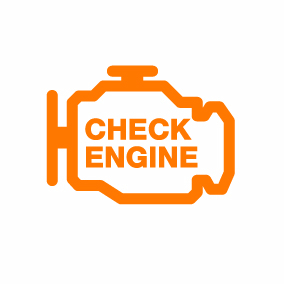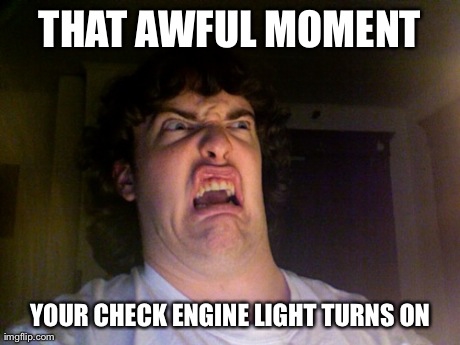The check engine light (otherwise known as the “ugh what now” light) is often times the first indication that something is wrong with our car. It’s also a light that we often times ignore, because we’re afraid of what it could mean for our poor little car.
I know this all too well. Whenever that light in my car goes on, my first thought is, “Eh – couldn’t be that bad. My car is running fine! It’s probably just a silly glitch.”
Then, as time wears on and the light doesn’t fade, my next reaction is, “Oy. OK fine – I’ll take it in . . . soon. Just not today. Today is not a good day; it’s raining and I have to take my cats to daycare! And they certainly cannot be late.”
And finally, after 100 other lame excuses, I go to start my car and . . . nothing. Boo. Guess I should have listened to that check engine light before it turned into a real full-blown issue. Now I have to spend $800 and am car-less for 3 days! Plus, my cats will not be awarded the golden paw award for purrfect attendance.
I’m guilty of putting things off when it comes to my car and justifying all the reasons for doing so, and I’m sure many of you out there are reading this thinking, “OH MY GOD. MITCH IS MY SPIRIT ANIMAL.” I know. I probably am. But that is not the whole point of this post. 🙂
The point of this post is to get us started off on the path of learning to identify what our check engine lights are in our bodies. In other words, what are those subtle signals that alert us that something is going astray internally?
Like our car’s check engine light, our body’s check engine light(s) is just as valuable. It allows us to intervene, to make adjustments, or to get ourselves checked out before things escalate and turn into a full-blown assault on our immune systems.
For me, I’ve discovered that I have several check engine lights. Here’s my biggest ones:
- My throat will feel like there is a lump in it
- My wrists and/or ankles will start to prickle with pain
- My head will have a dull ache to it (it’s a very distinct feeling)
- My “fibro” (as in, fibromyalgia) points along my body will start to hurt
- A flare-up of something else that rhymes with “shemorrhoids”…
Not everyone will have so many, or be aware of so many, but I’m sure that each and every one of you could probably identify at least one of your check engine lights if you really thought about it.
For me, I started figuring mine out because I’m a patterns guy. I notice patterns in everything; in the sky, in the roads, in numbers, in books and movies, and – most importantly – in my body. I began to recognize certain patterns that would occur as symptoms throughout my body whenever I’d do, eat, or even think certain things.
Some of this was trial and error. I’d check in with my body and take note that “OK, right now, at 3:55pm – I am feeling fine. No headache, no achiness, no lump in my throat.” Then, I’d test out a theory. For instance, maybe I’d eat a small piece of celery (it gives me a strange reaction) and immediately I could feel things start to happen in my body. My throat started feeling tight, my left wrist would start to prickle, the point above my right eyebrow would start to pulse; I could feel my check engine lights coming on, warning me to veer in a different direction.
Other times, I wouldn’t need to “induce” any types of symptoms (and frankly, wouldn’t suggest that route unless you’re really in-tune with your body). I’d just simply start taking notice of when I was feeling good and then as soon as something would change, I would begin retracing my steps back to what I had ingested or done right before my “check engine light” came on. In this way, my check engine lights became valuable clues about what I needed to adjust in my life.
As I continued tuning in more frequently and deeper with my body, I could finally identify what all my check engine lights were and – eventually – what the triggers of those check engine lights were.
For this particular activity though, all you need to be able to do is say, “Huh. Interesting. My check engine light is going off!” Don’t stress too much about being able to identify every single one right off the bat – you’ll get there. Just start paying attention and noticing the subtleties in your body. Things that can help you get in touch with your body are meditation, yoga, and just sitting quietly with your eyes open or closed – just as long as you’re quietly listening, it doesn’t matter how you’re sitting or standing.
The other thing that’s important about noticing your check engine lights is being action-oriented. You’re noticing, and then you’re acting. In the words of Edmunds.com, “Don’t just turn it off. Fix the problem.” Don’t wait for your subtle signals to become raging issues; take note and nip it in the bud by taking steps to correct the problem.
For example, whenever my check engine light is going off, I immediately turn to water to try and flush out whatever I may have ingested. Then, I write myself a prescription for some R&R, meditation and way less stimulation (i.e. no electronics!). I’ll also go easy on the diet for a day or two if it gets too bad, allowing my system to calm down and reset itself.
Those are just the steps that I found work best for me though. There are lots of ways to identify your check engine lights and what you should do about them, and every person is going to be a little different with how they listen to their body and identify what they are. You may find that yours is a ringing in your ears or a twitch of your eye, and that your personal “prescription” is taking a nature walk, calling a friend and drawing a bath. Again, listening to your body is the name of the game here.
While each of us may have our own way of listening more in-depth to our bodies, the important thing is just that we start. Because if we can begin to listen more intuitively to the messages our body is trying to send us, we won’t find ourselves starring in our very own episode of “The Disease Strikes Back” like I did not too long ago. Instead, we’ll be able to be proactive about our health and giving our bodies what they need (or don’t need) to keep them running smoothly.
So, what are some of your check engine lights?






Brilliant post, Mitch! You are DEFINITELY one of my spirit animals! Thank you!
I’ve been starting to notice some of my check engine lights this week and didn’t know if I should pay attention or not! I have some of your lights, for sure! Others are different. Achy joints, sore back of the neck, a specific headache above my left eye, stuffy nose, these are just some of my engine lights. I was just sort of casually watching them with no sense of urgency.
I realize NOW that I’ve read your post that I should PAY ATTENTION AND GET BUSY! So thank you for bringing this to my attention! I’m definitely going to try some of your steps to possibly avoid an all-out engine failure!
You ROCK, Mitch! Thank you so much!
Thank you for all the kind words, Marcia! So glad this article resonated with you and has helped you to take note of some of your own check engine lights! Thanks for reading 🙂
“Check engine light” — What a great way to put it! I also consider emotional eating a dashboard signal that something’s wrong under the hood (head, heart, or soul) that needs attention. (Wrote about it here: http://ohthatstasty.com/health-nutrition-info/5-steps-to-address-emotional-eating/) But thinking of physical symptoms that way, too, is a great idea.
A sneeze means get in bed now! Problems thinking of a simple word or thinking one word and saying another equals Epsom salt bath and rest. Headache, sure sign need to flush with water. Stinky pits-girl, you better start eating cleaner.